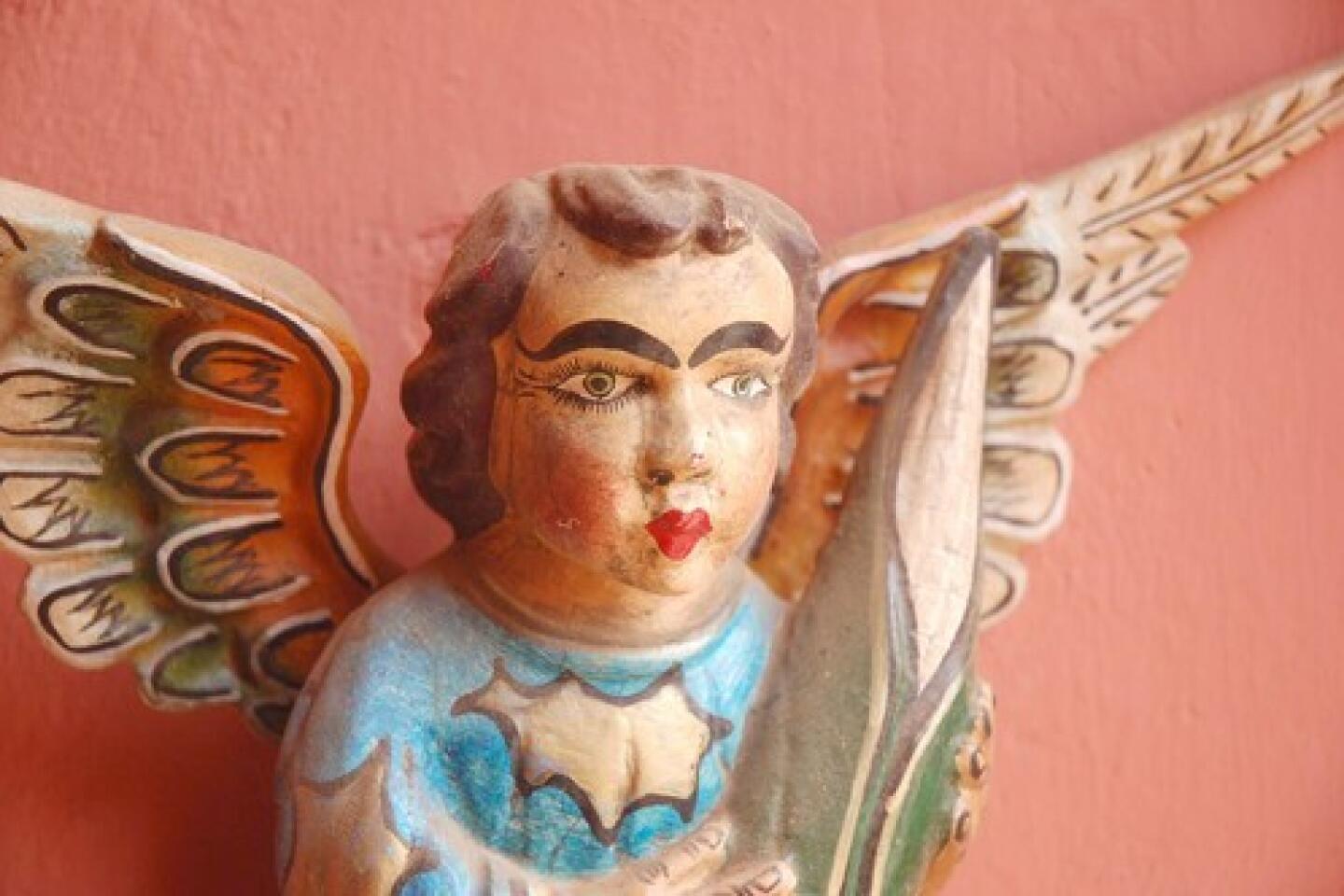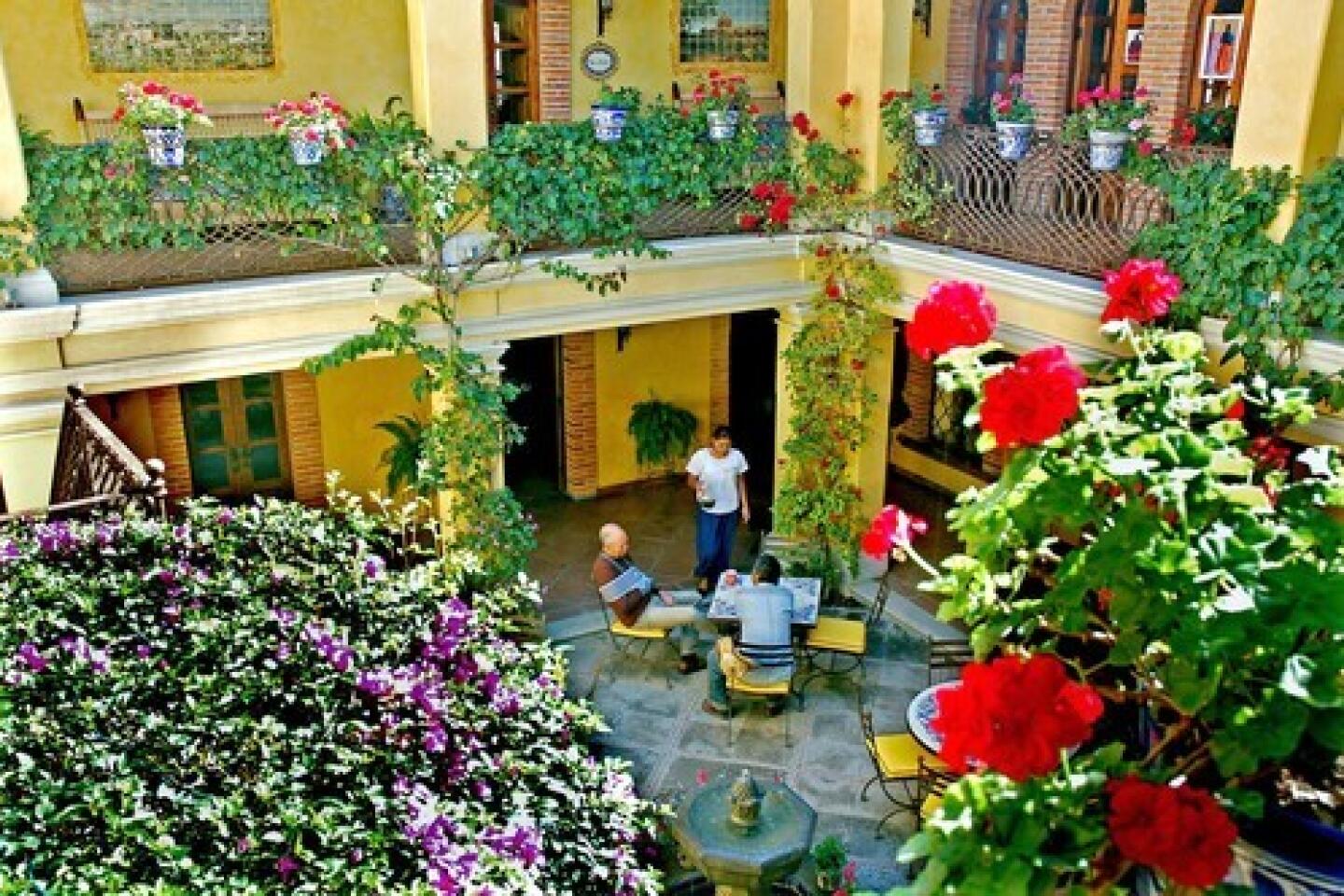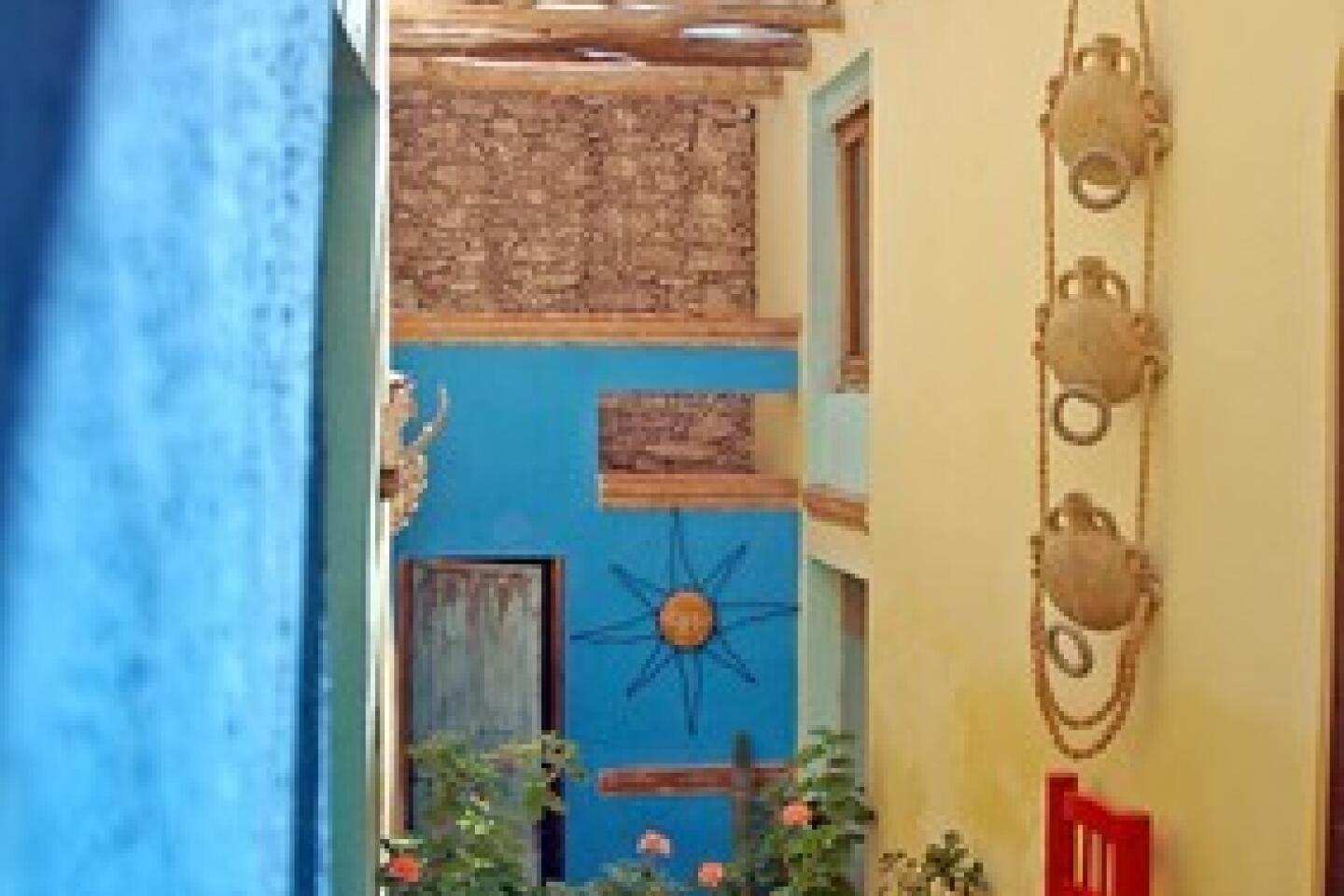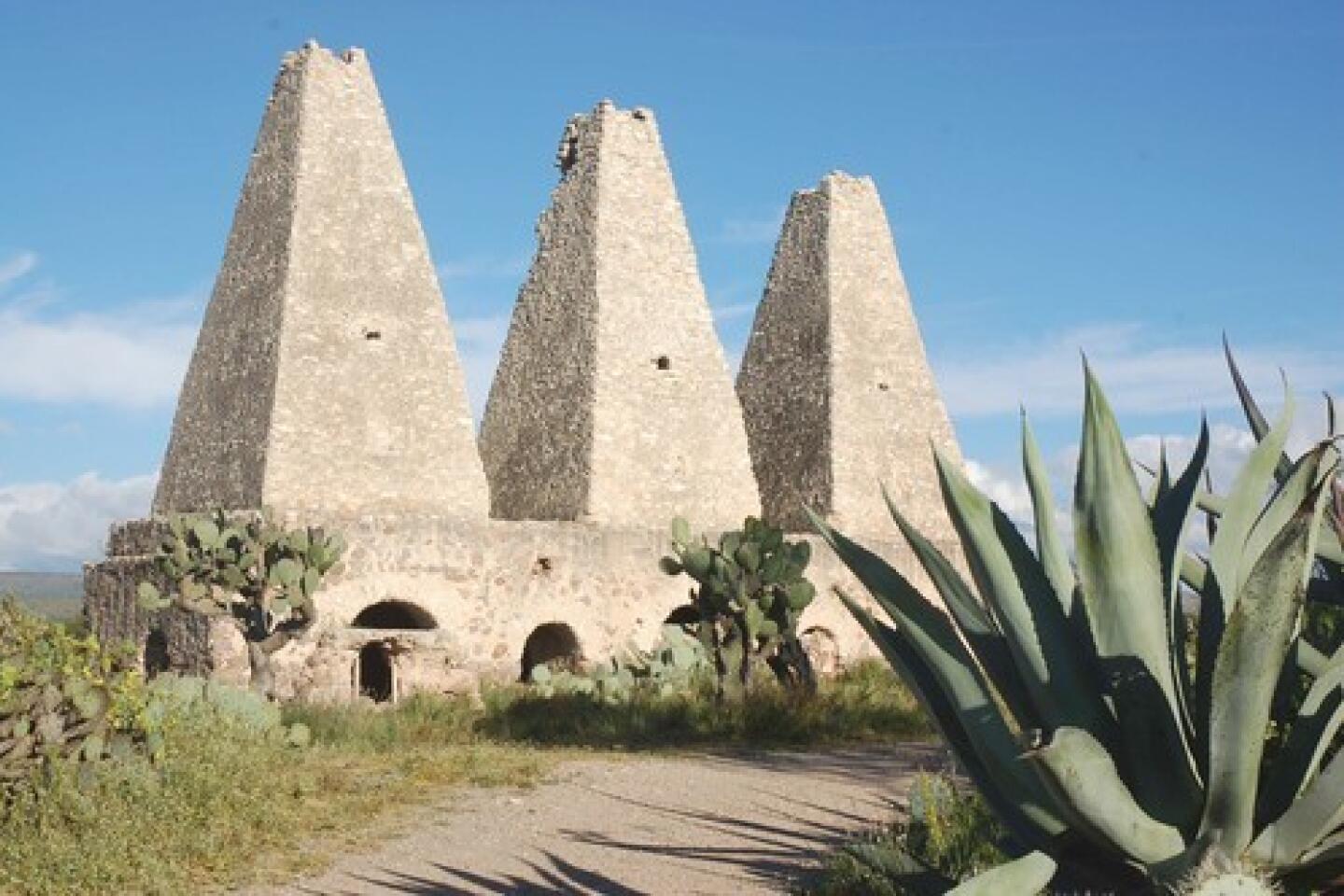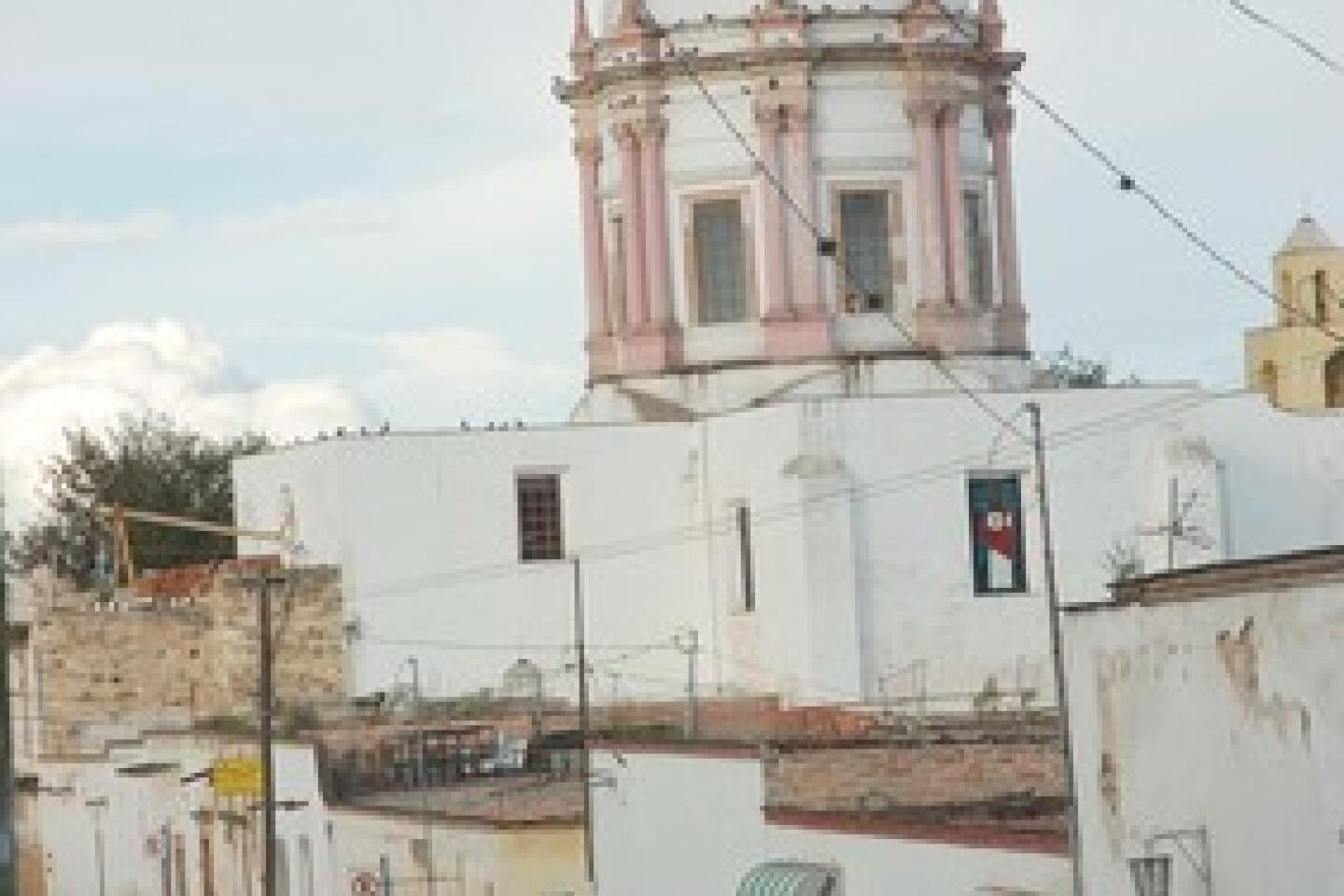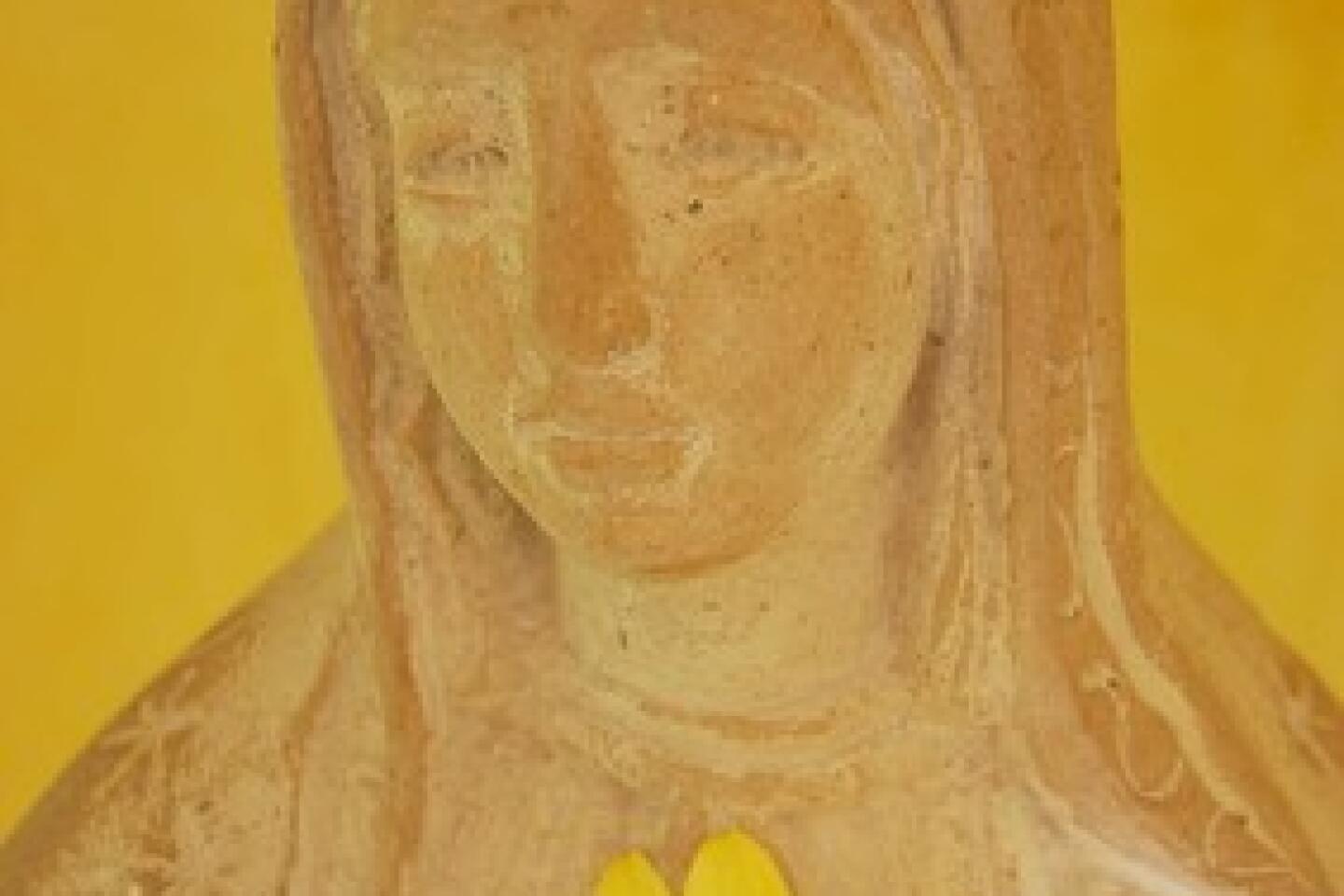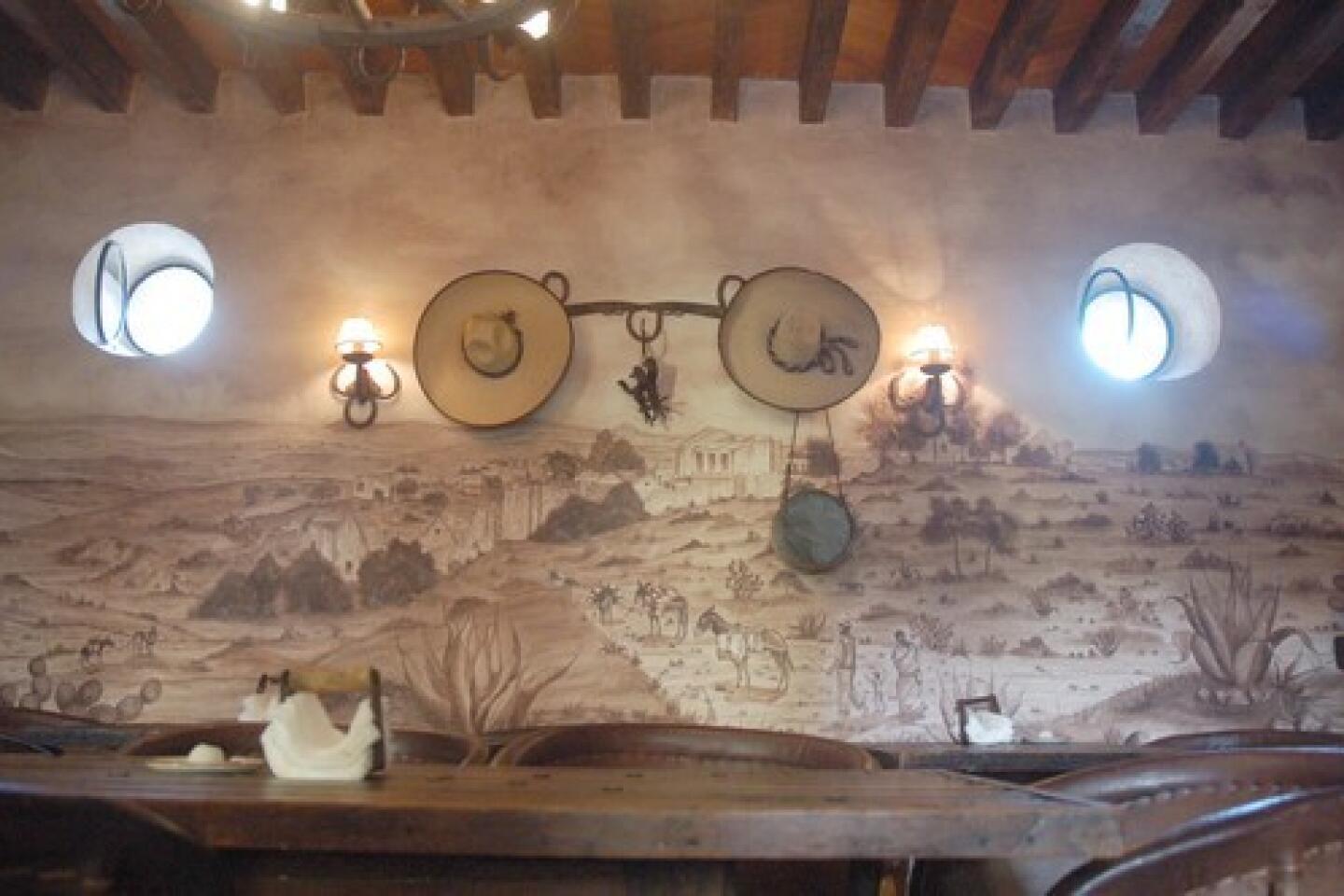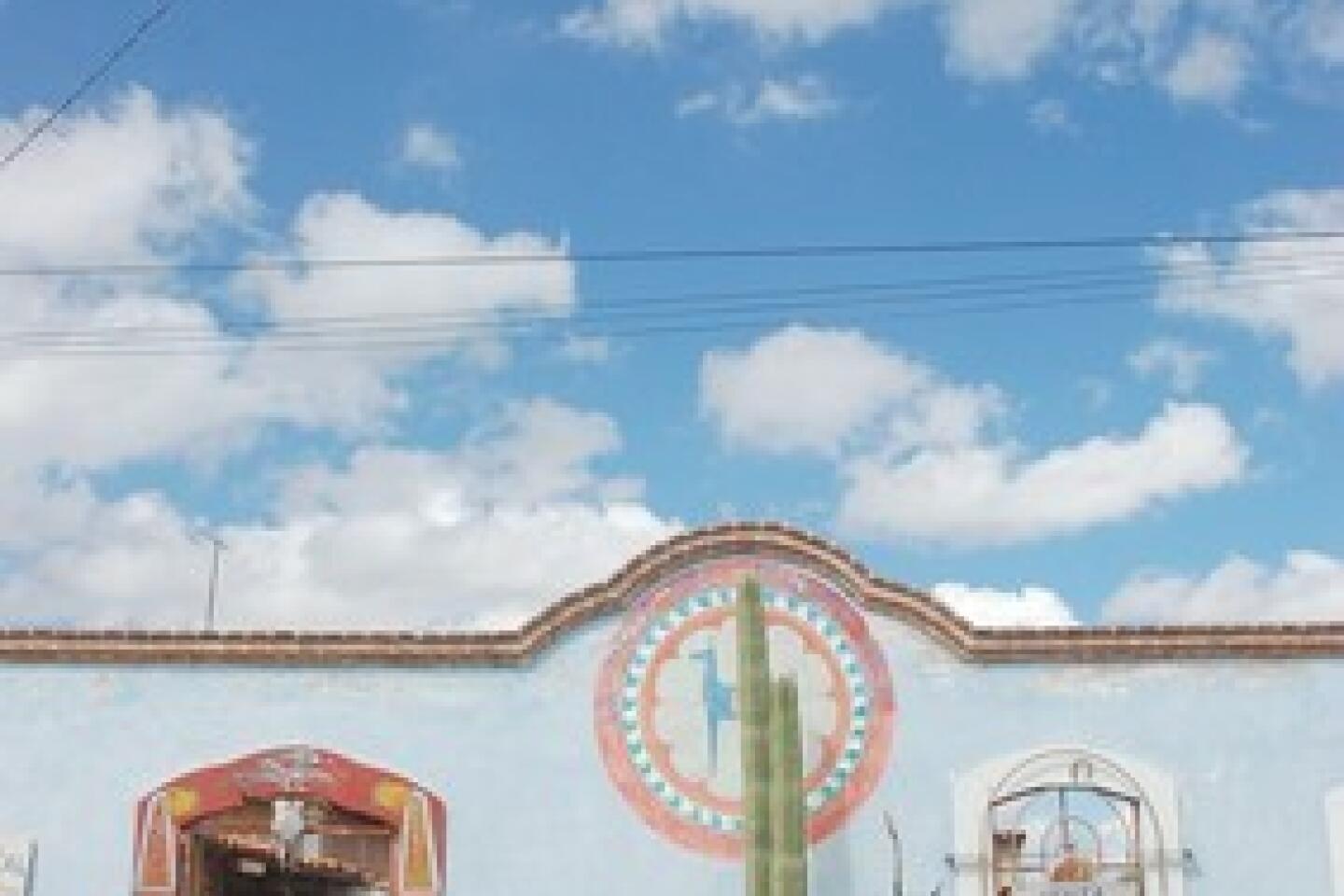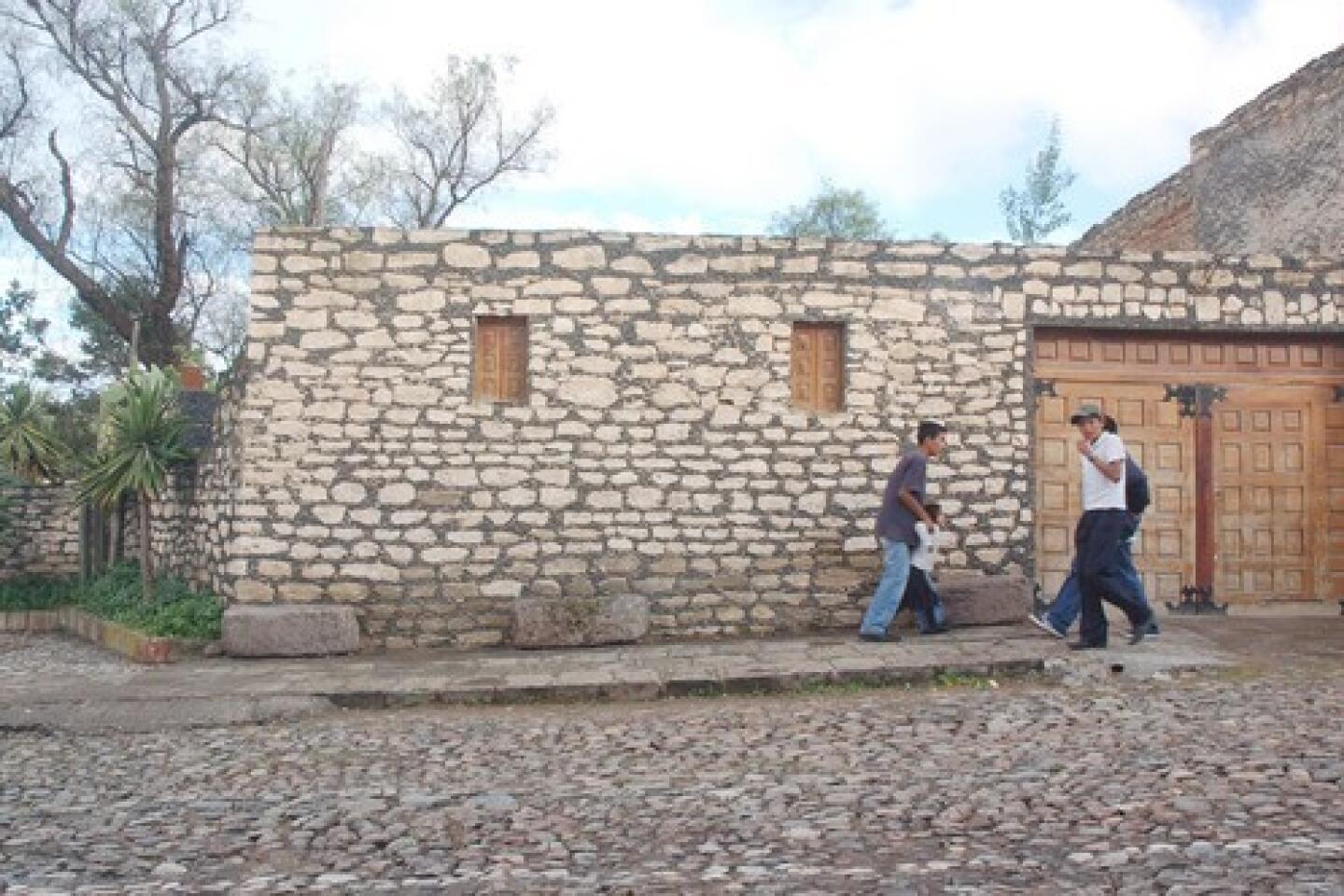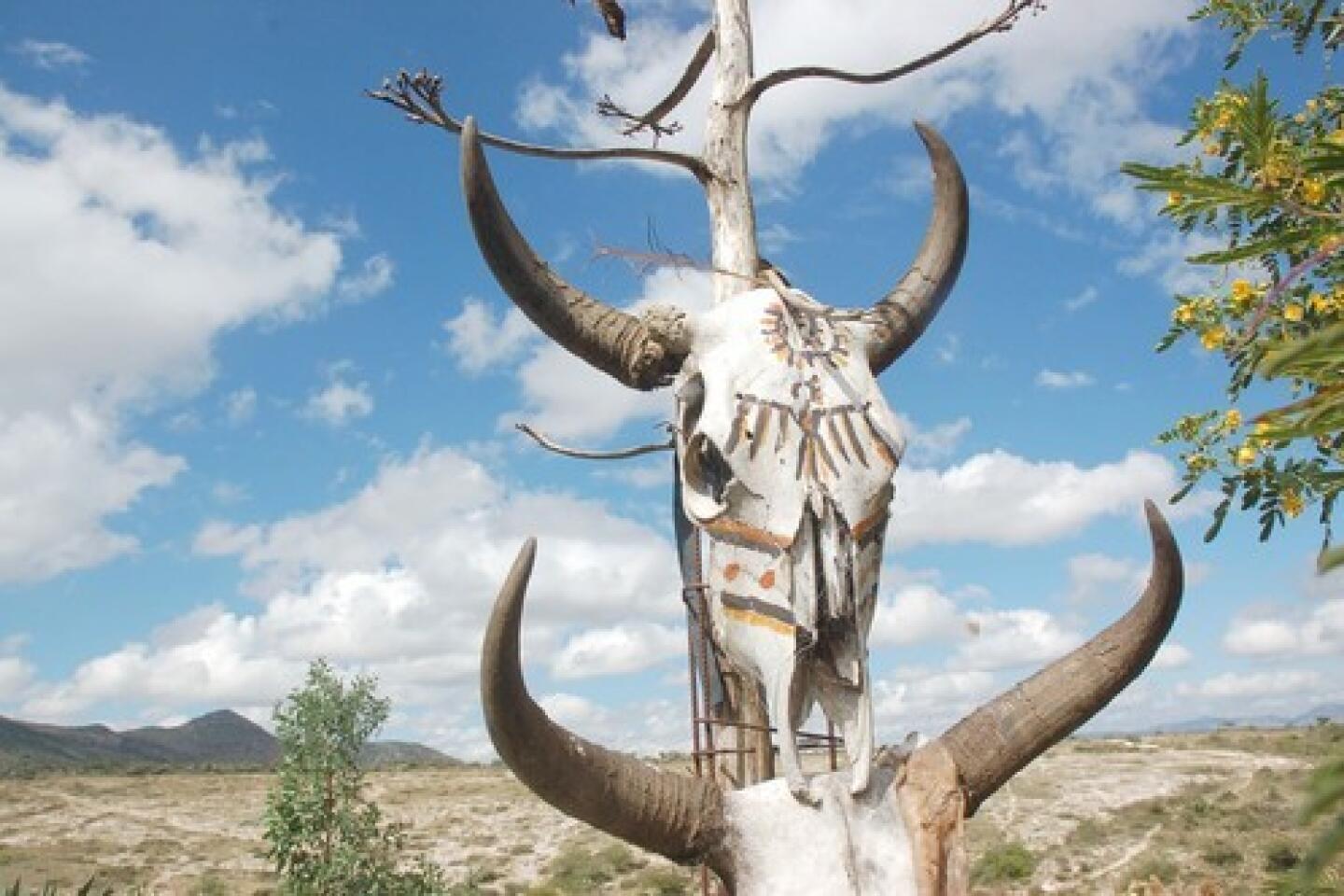Mexico’s Mineral de Pozos: A ghost town comes alive as an artist colony
- Share via
Reporting from Mineral De Pozos, Mexico — I arrived in eerie, old Mineral de Pozos in the middle of a half-sunny afternoon, with cotton-candy cloud shadows creeping all over the adobe rubble, the reclaimed ruins, the cactus thickets and the little-trod cobblestone streets. ¶Never heard of the place, a hotel clerk had said in Spanish as I prepared to make the 50-mile trip here from Querétaro. ¶ Another clerk piped up, I have. It’s small. ¶Very small, said a taxi driver. ¶ Now I was here, paying the cabbie, waving goodbye, turning to face a scene as dusty and forsaken as the one Butch Cassidy and the Sundance Kid found upon their cinematic arrival in Bolivia. ¶ Bleached skulls hung atop old poles. The hands on the clock that towered over the main plaza were frozen. At an abandoned chapel that now serves as a goat pen, 4-foot cactuses rose from the eaves. I could have fired a cannon in that main plaza and hit nobody, although it might have disturbed a sleeping dog or two.
The Mexicans call their ghost towns pueblos fantasmas, and Mineral de Pozos -- about 185 miles northwest of Mexico City and 40 miles northeast of San Miguel de Allende -- is one of them, a relic from the great Mexican mining boom of the late 19th century.
But Pozos isn’t dead. It’s slowly growing, its ghosts joined by perhaps 3,500 residents who have begun filling the reclaimed ruins with contemporary art and pre-Hispanic music. The town has three hotels, eight to 10 art galleries (depending on how you count them) and perhaps 50 Americans, many of them artists, who live here at least part time.
But none of that quite gets at the nature of the place. If the Mexican acordionista Flaco Jiménez and Texan guitarrista Willie Nelson ever team up to make a concept album about regret, decay, renewal and high-desert succulents -- which they should -- they’ll have to shoot the cover photo here.
I found my hotel, the Casa Montana, asked about a guide and soon was shaking hands with Marco Antonio Sánchez, whose family history tells the story of Pozos: His grandparents worked in the mines. Sánchez, on the other hand, earns his living by making, selling and playing pre-Hispanic musical instruments and occasionally guiding newcomers like me. (We spoke mostly Spanish, but he seemed to understand every word I uttered in English.)
We started our tour in the middle of town, where forsaken structures seem to outnumber occupied buildings about three to two. Out on the edge of town, the ratio is more like 10 to one. And then there are the outskirts.
At one rustic crossroads between town and the Santa Brigida mine to the northeast, we stopped to ask a local named Pepe Fernández about road conditions.
“It’s ugly this way,” he said in Spanish, looking up one rugged path. “But it’s uglier this way,” he added, looking up another.
Still, it was only a few miles. Before long, we were crouching amid the ruins of an old mining hacienda, the sky spread above where a roof should have been, peering into the black depths of an old well (pozo).
Muy profundo, Sanchez warned me. (Pozo: well. profundo: deep.)
At the Santa Brigida, a trio of bulky stone ovens loomed like pyramids or maybe smokestacks on a half-buried cruise ship. At the Hacienda de Cinco Señores mine on the west end of town, the buildings arched and sprawled down the hillside, the walls riddled with strange openings that once held all sorts of mineral-extraction machinery. Crazy sunbeams and shadows all over.
Some of the old mine sites are owned by individuals, some are owned by ejido, or communal, organizations, and some are in dispute. Sometimes a modest admission fee is asked, sometimes not.
As for measures to ensure safety or prevent vandalism -- there are nearly none. At Santa Brigida and Cinco Señores, the biggest sites, deep shafts were minimally marked. It’s a rotten place for unsupervised kids, an excellent place for hiring a guide. (There are a couple of them in town who speak more English than Sánchez.)
I’m not proposing Pozos as a honeymoon spot either, and I recognize that most travelers probably wouldn’t choose this destination by itself. But Pozos lies just under an hour’s drive from San Miguel de Allende, one of the bigger magnets for culturally inclined tourists in all of Mexico; about an hour from Santiago de Querétaro, which has a fascinating historic center and a convenient airport; and about two hours from Guanajuato, another artsy town that’s rich in history and collegiate energy.
So if you’re a painter, photographer, history geek, architecture dweeb, mineralogy wonk or just a seeker of singular landscapes, this could be the beginning of a larger adventure.
And it’s a cheaper adventure now: After two years of trading at 10 or 11 pesos to the dollar, the peso on my visit last month had weakened to about 13 to the dollar.
Security will be a question, but if you comb through the U.S. State Department’s 34 paragraphs of current crime-and-safety warnings to tourists in Mexico, and Pozos doesn’t come up. Several locals told me the crime wave elsewhere hasn’t made much difference in daily life here, except perhaps to slow the flow of visitors.
Every May, there’s a mariachi festival; every July, a pre-Hispanic music festival; every September, a celebration of the nopal and maguey plants. (The nopal, a.k.a. prickly pear cactus, is an occasional ingredient in tacos and egg dishes. The maguey, a.k.a. agave, is an indispensable ingredient in tequila.) There are art walks in summer and winter, and one or two home-and-garden tours annually.
For a few years now, Fernández has been leading horseback tours, charging about $20 per person per hour. This year, two galleries and two craft shops have opened.
As I drifted off to sleep that first night, on a four-poster bed in a spacious, well-appointed room, I imagined the whole town as an artifact carried back by an artist to the studio -- not a conventionally pretty artifact, but an absorbing one, evocative, compelling, mysterious.
And then I wished I had aspirin, because Pozos is about 7,500 feet above sea level and my altitude headache didn’t subside until the next morning, when Sánchez led me through the landmarks of the town’s resurgence.
Of course, Teresa Martínez was on the itinerary. Fifteen years ago, Martínez told me, she’d come to town to lock herself up for two years and write a novel. Instead, Martínez (who was born in Monterrey, Mexico, but spent many years studying and working in California and New York) wound up launching herself as an entrepreneur.
By 1995, she had converted a former cigar factory into a five-room hotel/restaurant/gallery. In one guest room at her Casa Mexicana, a 20-foot living pepper tree shoots through the ceiling. Another, known as the Tower, is arranged as a four-level loft, suitable for a Mexican Rapunzel.
After all these years as a pioneer, Martínez admits to some weariness. In fact, she recently closed her restaurant, Cafe des Artistes, and cut the Casa Mexicana to Thursday through Sunday nights. But she has also added spa services and massages and may reopen the restaurant in January.
The next chapter in the Pozos story stands next door: the Casa Montana, a hotel/restaurant/gallery that came along in 2000, giving Martínez competition but also reassuring her that, in her words, “I wasn’t crazy.”
This venture was created and is run by Susan Montana, an expat from New Mexico. Instead of taking on a ruin, Montana built from scratch, hiring laborers who used the same local chipped-stone masonry style seen in buildings all over town. (Martínez and Montana also both double as real estate agents, courting American buyers with rehabbed houses priced as low as $95,000 to more than $300,000.)
But the latest lodging competition in town -- and the most formidable -- is the Posada de las Minas, opened in 2005 about a block up the hill and designed and run by David and Julie Winslow of Houston and Pozos.
It’s the largest lodging in Pozos (eight rooms), festooned with folk and contemporary art, with a central courtyard, restaurant, whirlpool and gardens, the interiors as saturated with color as the streets outside are bleached by the sun.
When they bought the property, David Winslow told me, “There were no ceilings and no floors on the second level. And only one of the columns in the courtyard was standing.” Now there are six columns around that courtyard and a retractable roof above. Next time, I’ll stay at the Posada de las Minas.
As with the other lodgings, the Winslows’ inn gets most of its visitors on weekends (when the galleries are open), and summer and winter are much busier than spring or fall. Though most overnight guests in town are upscale Mexican travelers, all three innkeepers aim to woo Americans seeking a smaller, slower San Miguel de Allende.
By the way, if you’re keeping score at home, you’ve counted a collective 18 rooms in the town’s three hotels. In my rounds, I saw 17 of them. (One lock was broken.) And I came to realize that on the night I arrived, I was the only hotel guest in town.
Alas, the solitude didn’t last. Before the next morning, a quartet of stylish, Spanish-speaking women turned up for a meal at the Casa Montana, and a couple of photographers had checked in at the Posada de las Minas. But in a town like Pozos, it’s easy enough to imagine being an Omega Man.
Pozos was born in 1576 as a mining town, and grew in fits and starts alongside half a dozen other boomtowns in the high, rugged central region that Mexicans call the Bajío. By the last years of the 19th century, the number of working mines had reached 300 and the population in Pozos alone had reached 70,000.
But then came the Mexican Revolution of 1910. Mines began closing down, and many flooded. Silver prices fell. And it didn’t help that many Pozos residents were militant Catholics at a time when the Mexican government was dominated by anti-Catholic forces. Pozos was doomed.
By the 1950s, some say, the town had shriveled to about 200, and it became a half-forgotten exurb of the small city of San Luis de la Paz, about 5 miles away.
Still, if you look closely up the streets of Pozos, you see signs of its new bohemian life.
In 1982, the Mexican government declared the town a national historic treasure. On Calle Centenario and Leandro Valle, two streets that miners used to walk to work, the Sánchez workshop, Camino de Piedra, is one of three storefronts devoted to the making and selling of pre-Hispanic musical instruments, mostly drums, flutes and whistles.
Three more instrument-makers are scattered elsewhere in town among the galleries and studios, including Galería 6, which Nick Hamblen and Manrey Silva opened about four years ago.
Their live/work space, on the Jardín Principal near the Casa Montana and Casa Mexicana, includes a generous garden, a pair of battered cowboy hats hanging on the stone wall, a bevy of pet birds, and a jar full of yellow and green feathers. Most of their sales -- as diverse as abstract paintings and photography -- are to American visitors and expats, and most of the art they show is made by expats.
Another studio and gallery belongs to Dan Rueffert, an artist who spent three decades in nearby San Miguel, then bought property here and invested in a restaurant. Now he can stroll two blocks from his almost-finished home to the eatery he co-owns, Los Famosos de Pozos.
If Rueffert continued two more blocks, he’d be at the high-walled house of Beverly Sky, a fiber artist and paper-maker from Boston who first saw the place five years ago and now spends about four months a year here. For “the price of a parking space on Beacon Hill,” she bought an artist’s home with 150-year-old walls and a triangular courtyard. As she showed me around, the morning chill eased and the courtyard lighted up.
“This is classic Pozos,” she said. “A little bit cold and chilly, and then the sun.”
I headed back out to the dusty street, where a tethered horse sipped from a bucket. In the town’s only bar, the barkeep hunkered down beneath his collection of boxing posters and historic photos.
I flashed back to a moment out at the mine site the day before. I was coming up a hill, a few steps behind Sánchez, when he abruptly halted, grinned and pointed.
Coyote, I thought.
But he was pointing at a prickly pear cactus in front of a crumbling wall. Working with something sharp, some man, woman or phantom had carved a near-perfect cross out of the flesh of the cactus. The bright blue sky and fast-drifting clouds shone through the freshly cut-away shape.
“Never seen it before,” Sánchez said.
Pozos. Pueblo fantasma.
Reynolds is a Times staff writer.
latimes.com /pozos Hidden gems View more photos of the quiet beauty and artistryof Mineral de Pozos.
More to Read
Sign up for The Wild
We’ll help you find the best places to hike, bike and run, as well as the perfect silent spots for meditation and yoga.
You may occasionally receive promotional content from the Los Angeles Times.
